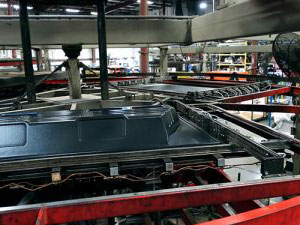We're looking at why companies choose pressure forming to manufacture custom plastics and the common…
Thermoforming offers fast lead times and low initial start-up costs, making it an ideal manufacturing option for low-volume orders. Additionally, it's a much easier and faster method of making large plastic components, including shipping totes, vehicle dashboards, and even bathtubs. Most thermoformed plastics are shaped either through vacuum forming or pressure forming, but which one is right for your next project? To help you understand your options, our plastic manufacturing company in North Carolina is breaking down what each one is, when they are most often used, and the pros and cons.
How Does Vacuum Forming and Pressure Forming Work?
All thermoforming starts by heating a large sheet of plastic until it's pliable and fitting it around or inside a custom made mold.
 Vacuum Forming involves using powerful vacuum pressure to pull the plastic tightly against the mold to create the necessary shape.
Vacuum Forming involves using powerful vacuum pressure to pull the plastic tightly against the mold to create the necessary shape.- Pressure Forming involves suctioning air out from below the plastic (similar to vacuum forming) to pull it against the mold while a powerful jet of air is pressing the plastic into the mold from above.
Once the plastic is shaped, CNC and robotic trimming is used for any finishing to get the smooth edges and detailing necessary for precise results.
Pros and Cons of Vacuum Forming
The main benefit of vacuum forming is that it's the lowest-cost method of shaping and molding plastic. Because the vacuum doesn't require as much pressure, a lighter weight and less expensive metal can be used to create the tooling, which not only keeps costs down, it's faster to produce.
The drawback of vacuum forming is that because of the low amount of pressure exerted, it's not possible to get precise details and sharp angles or corners. Instead, you'll get rounded edges and curves.
The pros and cons of vacuum forming mean that this method of manufacturing is best for large item production of less-intricate components. Vehicle dashboards, refrigerator liners, and food trays are often produced this way.
Pros and Cons of Pressure Forming
Pressure forming offers almost the opposite of vacuum forming. The high pressure used to pull and push the plastic firmly against the mold ensures the precision, intricacy, and sharpness you may require while still easily forming large pieces of plastic. It's often used as a lower-cost alternative to injection molding as it can often get similar results more efficiently.
On the other hand, the high pressure does require sturdier tooling which means that the initial costs will be a bit higher than those of vacuum forming, but still much less than injection molding.
Choosing the Right Method of Manufacturing Custom Plastics
When you're choosing which type of plastic forming is right for your next project it's important to consider what you need from your component. If you need crisp lines, sharp angles and corners, and intricate details for a large plastic product, pressure forming will most likely get the results you need. On the other hand, if you're concerned with cost and you don't require the higher level of detail, vacuum forming may be the better option for your project.
It's important when you're sitting down with a design and engineering team that you discuss what the plastic will be used for, what your priorities are, and what kind of shape you need. They will work with you to not only determine the right method of manufacturing, but if any additives are required to get an improved performance, such as UV protection, anti-static coatings, or texturization.
Contact Us for Your Custom Plastic Manufacturing Needs
At Advanced Plastiform, Inc., we have an experienced, dedicated team of designers, engineers, and manufacturers that allow us to serve a wide variety of companies in the automotive, medical, and construction industry. Whether your business is in North Carolina, South Carolina, Maryland, Pennsylvania, Georgia, Tennessee or Virginia, find out how we can customize your plastic component to help your product succeed! Contact us today to request your quote.

